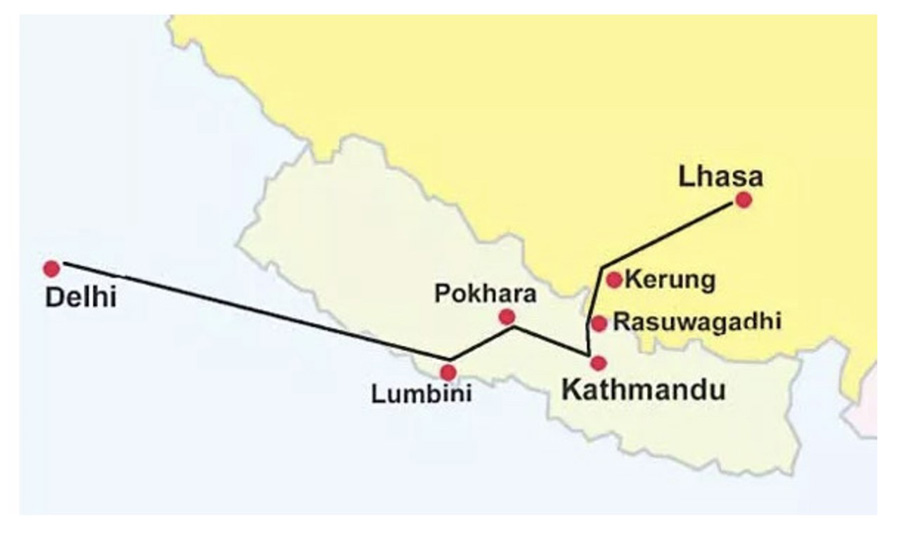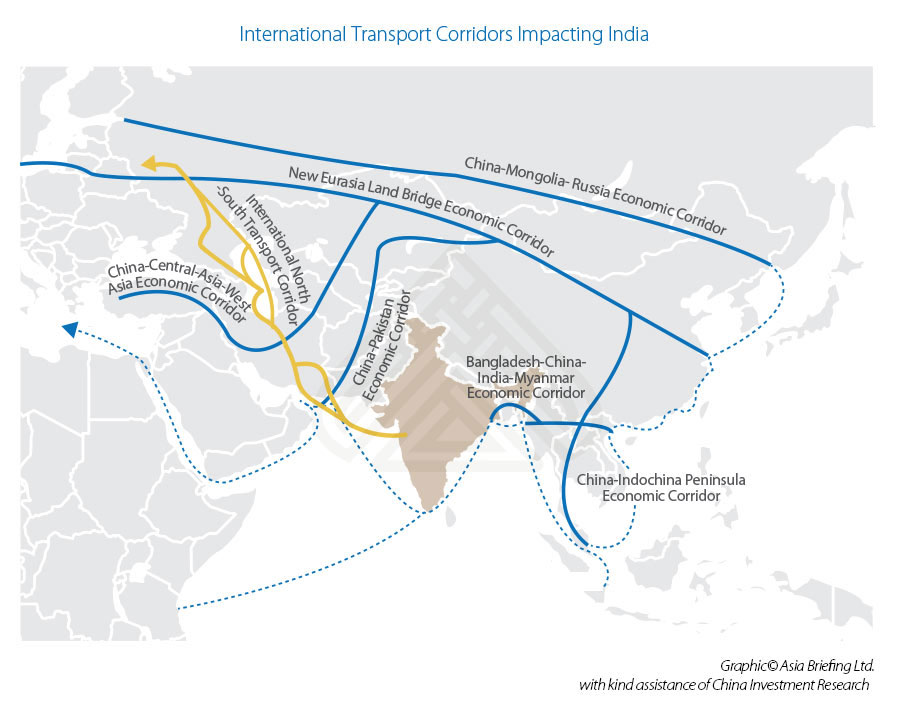China’s Latest Outbound Investment Target…And The Winner Is: India
Beijing and Delhi’s One Hundred Year Development Plan
Op/Ed by Chris Devonshire-Ellis
Much has been made of recent Indian regulatory issues being anti-China investment in tone, however they failed to read the small print. India is in fact the current largest recipient of announced Chinese outbound investment right now, which has risen from 1.8% of China’s total outbound investment spend in 2018, to 5.6% in 2019, and is currently at 7% this year to date.
While journalists make a big play about India not signing up to China’s Belt & Road Initiative (due to issues concerning territorial disputes in Kashmir and Arunchal Pradesh) the reality is that Indian Prime Minister Modi and Chinese President Xi Jinping have made reference to a “One Hundred Year Plan”, intended to help both reach their potential in Eurasian trade. While the Indian Prime Minister has not yet accepted this proposal, it remains in the air between the two countries and is currently open for discussion.
In October last year, President Xi met with Indian Prime Minister Modi in Chennai, their 2nd informal summit in 18 months. One key focus on the meeting was on trade, which included inviting Indian pharmaceutical and information technology companies to conduct investment/cooperation in China as a way of addressing the trade deficit between the two countries.
Xi offered such a collaboration, and stated the priorities should be to map out a hundred-year plan for the relations from a strategic and long-term perspective. These include the establishment of friendly ties between Fujian Province and the State of Tamil Nadu, as well as between cities of Quanzhou and Chennai. Following his meetings in India, President Xi subsequently met with President Bidya Devi Bhandari; the first visit by a Chinese President to Nepal in 23 years. One of China’s goals is to help Nepal realise its dream of becoming a land-linked country from a land-locked one, thus infrastructure is critical.
These are not the sole initiatives and inter-connectivity projects underway. We can examine how India can cleverly managed to be both unofficially “in” and officially “out” of China’s Belt & Road Initiative as follows:
The Bangladesh-China-India-Myanmar Economic Corridor (BCIMEC)
What is effectively occurring with BCIMEC is a Chinese-Indian collaborative effort to rebuild the Silk Roads from Eastern India into Western China – a revamp of the old Stilwell Road sees Yunnan connected with Ledo, in India’s Assam, via Myanmar and Bangladesh. We wrote about that from the Yunnan perspective ten years ago.
The BCIMEC is a 2,800 km connectivity corridor that links Kunming in China, with Kolkata in India via Mandalay and Dhaka.

Map courtesy of China Investment Research
The Bangladesh Belt & Road
In 2016, Bangladesh and China signed 27 agreements for investments and loans worth around US$24 billion during President Xi’s visit to Dhaka that year. Together with the US$13.6 billion invested in earlier JVs, Chinese investment in Bangladesh now totals @US$38 billion, making China Bangladesh’s single largest investor and Bangladesh the 2nd largest recipient of Chinese loans under BRI in South Asia.
Pakistan, with US$62 billion of Chinese BRI commitment, has a population of 200 million, while Bangladesh, with US$38 billion of BRI commitment has a population of 166 million. The China-Pakistan Economic Corridor (CPEC) may have taken up a lot of the attention, but its sphere of connectivity runs far wider – and indirectly impacts upon India.
In Bangladesh, much of the infrastructure is close to being completed, such as the Padma Bridge, on track to open next year, and when completed will be the largest bridge in the country. Then there is the Payra Seaport, a US$15 billion investment to create a deep water facility. Extensive dredging is taking place in Bangladesh’s notoriously silted water, and current progress is slow. This is also hindering the development of Bangladesh’s 2,000 MW power plant development, but – progress is being made.
China and Bangladesh have been negotiating and now decided to proceed with a 900 km highway to connect Chittagong and Kunming through Myanmar (the Stilwell Road mentioned earlier, and discussed for over a decade), and therefore lowering shipping costs/shipping risk. This also fits with their joint initiative of improving Chittagong port infrastructure.
Bangladesh and China are also developing a Chinese Economic and Industrial Zone (CEIZ) with an existing footprint of 781 acres close to Bangladesh Port, although a China built tunnel is critical to its connectivity with Chittagong. The CEIZ will specialize in chemicals, automobile assembly, garments, and pharmaceuticals.
Bangladeshi communications are also getting a major upgrade, although 4G is operational in Dhaka, most of the country still utilizes 2G. Huawei though has operated in Bangladesh for years and the Bangladeshi government is comfortable with that relationship, also realizing that putting in place a 5G network will mean investment capital and trade will follow. Bangladesh, with its youthful population, is focused on building a digital economy, similar to China.
The Myanmar Belt & Road
In January this year, China and Myanmar signed 33 agreements to accelerate the development of the China Myanmar Economic Corridor (CMEC),which was officially launched in 2018. While none of these were new, they brought new focus including fourteen of the MOUs aimed to strengthen collaboration in the infrastructure sector, including Kyaukphyu (deep water seaport) and SEZ, the Muse/Mandalay Railway, which at 431 km links Yunnan to Mandalay; the Three Border Economic Cooperation Zones; the Myitsone Hydropower project, which has been blocked since 2011 but now restarted; the Myitkyina Economic Development Zone, in addition to the New Yangon Development, a new city project in Myanmar’s commercial capital.
The Nepal Belt & Road
During the China-Nepal meetings, the two countries signed 20 cooperation agreements, one of which was a pledge of US$500 million in financial aid over the next two years. They also agreed to a 70 km extension of the existing Qinghai-Tibet railway to Rasuwagadhi, then onto Kathmandu and Lumbini (birthplace of The Buddha). This represented a small component, with much lower financing amounts that had been pre-empted a year earlier by a China pledge to than previously discussed US$8.3 billion for a series of infrastructure projects, most of which was around the construction of trans-Himalayan connectivity to include ports, 540 km of highways, operational by 2025 and to include rail, air and communications. Ultimately, these will link into Uttar Pradesh and could conceivably become a Nepal-India-China corridor. Nepal also has 84,000 MW of Hydropower Potential – of which 43,000 MW could be economically viable. This energy can be sold onto countries with power shortages, such as Myanmar, Laos and the rest of South-East Asia.

Map courtesy of China Investment Research
The New International Land-Sea Corridor
The New International Land-Sea Trade Corridor (ILSTC) is a trade and multimodal transport corridor jointly built by the western Chinese provinces and the ASEAN countries. The ILSTC treats Chongqing and the Beibu Gulf ports of mainland China, Hong Kong and Singapore as different transport hubs through which it attempts to link the western provinces of China with the Indochina Peninsula, the ASEAN region as well as the BCIM. As at Q1 2019, eight western provinces, autonomous regions and municipalities, including Chongqing, Guangxi, Guizhou, Gansu, Qinghai, Xinjiang, Yunnan, and Ningxia, had joined the ILSTC. Shaanxi joined in May 2019.
With Chongqing as its centre, the corridor offers an alternative for western Chinese provinces and autonomous regions other than shipping goods from the east coast. It is also a strategic channel connecting the “Belt and Road” Initiative and the Yangtze River Economic Belt. International trade among the ASEAN countries, Central Asia and the EU can also be improved by the existing China Railway (CR) Express service from western Chinese cities.
Impact On India
This means that India is set to become a focal point for two major infrastructure and trade routes with China, and by proxy, a major (unofficial) player in China’s Belt & Road Initiative. This has huge implications for regional trade between China and India as well as with Bangladesh, Myanmar and Nepal.
These plans will further connect India with Bangladesh, India and Nepal, therefore giving a southern and northern route from India overland to China; a southern route via Bangladesh and Myanmar, and a northern one from Uttar Pradesh through Nepal, heading east and through Tibet joining the Chinese national rail network. They also link the country, and especially its under-developed eastern seaboard, with the massive potential of the ILSTC routes, meaning matching infrastructure developments can be expected to arise along the East Coastal and Coromandel coasts of India.
Further north, I have been to the southern part of Tibet, on the border with India, at the confluence of the Brahmaputra River overlooking Aranachal Pradesh. The Chinese infrastructure is all in place, all that needs to happen is for India to reciprocate. That is likely to occur when India’s Senior Generals, long educated in the China-India border war in 1962 and the China threat for decades, start to retire and their influence wane. That is happening now. South-Eastern Tibetan cities such as Nyingtri are waiting and available to receive goods and ship them from China to India via Lhasa and vice versa.
China and India have agreed much more than developing infrastructure and trade routes however. The hardware done, and being built, has seen bilateral trade developments take place. Here, Xi and Modi have essentially agreed on trade, with India pharmaceuticals being allowed access to the China markets, and China being given access to Indian tech.
Much has been made of the recent Indian revised FDI policies, with all projects from India’s neighbouring countries, which include Bangladesh, Myanmar, Nepal and China, all being required to have new projects vetted by New Delhi prior to approval. This additional step has caused confusion in some quarters, and been seen as a form of protectionism. In fact, it can also be viewed as a matter of obtaining clarity and instigated in order to provide a better co-ordinated programme of regional integration as highlighted above. It is a situation we touched on in our recent article How Will India’s Revised FDI Policies Impact Upon Chinese Investment?
India & International Land/Sea Transport Corridors
However, it is also true to say that some of the India infrastructure initiatives bypass Chinese infrastructure, at least for now. While India will make full use of the Eastern integration, to the West it is a rather different matter. China has massively invested in the south Pakistan Port of Gwadar, as part of its massive CPEC corridor. India, wary of both China and Pakistan’s intentions, and knowing there are very likely to be disruption created to Indian shipping using the Gwadar facilities, has instead linked up West bound with Iran’s North-South International Transport Corridor at the Iranian Port of Chabahar, and is a significant investor. The distance between Pakistan’s Gwadar and Iran’s Chabahar Port is just 72km; both are deep water facilities.
It should also be noted that India, Pakistan and Iran are members and observers of the Beijing initiated Shanghai Cooperation Organisation, and have a formal discussion platform to determine trade and connectivity issues away from the spotlight of what can be tense regional politics.

The International North-South Transport Corridor (INSTC)
From Chabahar, Indian goods can continue via sea further West, or join the International North South Transport Corridor (INSTC) which heads north before offering options east, and reconnecting India with Afghanistan and Central Asia and due north, where it connects with Russia and its trans-Eurasian railway.
The implications for India are immense. With sea and rail connectivity to the West, and the same to the North, East and South, the country is developing as a massive Belt & Road Initiative hub – all without actually being part of it. That has been some trick for Prime Minister Modi to pull off – but without doubt it promises to herald a new wave of investment into the country.
We are grateful to Henry Tillman and China Investment Research for a large part of the intelligence provided. China Investment Research are part of Grisons Peak Services, a UK based consultancy practice. See: www.chinainvestmentresearch.org and http://www.grisonspeak.com
Related Reading
- The New Foreign Investment Law in China

China has faced a deluge of international criticism over its treatment of foreign businesses and the perceived slow pace of market opening over the past year. Looking to restore the confidence of foreign investors, China passed a new Foreign Investment Law in March this year. The law establishes a new framework to govern foreign investment in China and addresses a number of common concerns among overseas businesses.  Establishing a Foreign Company in India
Establishing a Foreign Company in India
India is an attractive destination for foreign investors due to its large consumer-oriented market, low labor costs, and rising global competitiveness. Despite the recent dip in the growth rate, India features among the top 10 countries for global FDI. Further, with more sectors being liberalized and a focus on improving the ease of doing business environment, India offers a stable base of operations for investors seriously considering the Asian market.
About Us
Silk Road Briefing is published by Dezan Shira & Associates. The practice has 27 years experience of handling foreign investment into Asia and possesses 28 offices throughput the region, including multiple offices in China and India. To contact the firm please email silkroad@dezshira.com or visit us at www.dezshira.com





